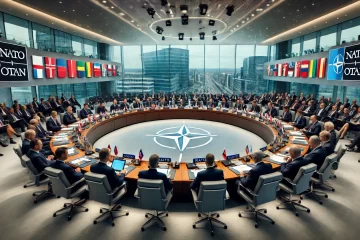The United States Air Force (USAF) is expanding the integration of stealth technology beyond fighters and bombers to encompass aerial refueling. Lockheed Martin’s Skunk Works proposed design for the Next-Generation Air-Refueling System (NGAS), the KC-Z, showcases this critical evolution as it addresses a significant vulnerability—the exposure of low-observable aircraft during mid-air refueling.
By incorporating stealth, the KC-Z can operate discreetly in contested airspace, safeguarding both itself and the aircraft it refuels such as the F-22, F-35, B-2, and B-21. Additionally, the enhanced capabilities of the KC-Z significantly extend operational reach, allowing aircraft to operate farther from their bases and demonstrate a rapid response to global threats, thus serving as a powerful deterrent.
Technical specifications and design details for the KC-Z are still under development. However, Lockheed Martin’s proposed design emphasizes stealth as a core feature, incorporating low-observable materials, shaping, and potentially radar-absorbing coatings. The KC-Z is expected to be larger than existing tankers to accommodate a substantial fuel capacity and potentially integrate advanced mission systems, such as enhanced communication and electronic warfare capabilities. The design will likely include features to reduce its infrared and acoustic signatures, further enhancing its stealth capabilities. Details about the refueling mechanism, boom or drogue system, are yet to be finalized, but it is expected to be compatible with various aircraft types, including fighters, bombers, and, potentially, unmanned aerial vehicles.
The KC-Z’s presumed ability to loiter for extended periods enhances the US military’s persistent presence in critical regions, reinforcing extended deterrence commitments to allies and partners. Although the US Congress has halted plans to phase out the current fleet of KC-135s until the USAF can submit a formal acquisition strategy for the KC-Z, the acknowledgement of the KC-Z’s importance as a definitive force multiplier that amplifies air combat capabilities through the enablement of longer flight durations, expanded mission support, and overall greater flexibility, further deterring adversaries, highlights the pivotal role the KC-Z will have by integrating with other advanced platforms by enabling coordinated operations across multiple domains.
While the exact timeline and cost of the KC-Z project remain fluid, current projections estimate the first operational aircraft to be fielded by 2040. The USAF is currently in the initial phases of the acquisition process, with a request for information issued in early 2023. This will be followed by an analysis of alternatives to determine the specific requirements and design of the NGAS, which includes the KC-Z. The development of a stealth aircraft with aerial refueling capabilities is expected to be a complex and costly endeavor, with estimates reaching into the tens of billions of dollars. However, proponents argue that the long-term strategic advantages and enhanced operational capabilities justify the significant investment.
Despite the potential advantages, the development and deployment of the KC-Z faces significant challenges. The high cost associated with developing and maintaining stealth aircraft raises concerns about the project’s overall cost-effectiveness, especially considering the budgetary constraints in the defense budget. Additionally, questions remain about the long-term viability of maintaining the KC-Z’s stealth profile, given the wear and tear of regular operations and potential advancements in radar technology by adversaries. Some argue that investing in alternative refueling solutions, such as unmanned tankers or ground-based refueling systems, might be more practical and cost-efficient. Furthermore, integrating a new, complex platform like the KC-Z into existing air operations could pose logistical and operational challenges, requiring substantial adjustments to training, tactics, and maintenance procedures.
Though the Next-Generation Air-Refueling System (NGAS) includes the KC-Y or “bridge tanker” that will close capability gaps between the future KC-46 and KC-Z, recognizing the importance of stealth design in aerial refueling airframes to the deterrence mission will strengthen the United States deterrence strategy by expanding operational capabilities in contested environments, projecting power globally, maintaining a persistent presence, multiplying force effectiveness, and fostering integrated operations. The KC-Z represents a critical evolution in air refueling, aligning it with the demands of modern warfare.
The development of the KC-Z places the U.S. at the forefront of aerial refueling technology, potentially sparking a new arms race as other nations seek to maintain parity or develop their own stealth tanker capabilities. This could have significant implications for international relations and global security. While the KC-Z is primarily intended for defensive and deterrence purposes, its potential offensive applications could raise concerns among rival nations, further fueling geopolitical tensions. Conversely, the KC-Z could also act as a deterrent by showcasing American technological prowess and bolstering alliances with countries that benefit from extended airpower projection capabilities. The international community will undoubtedly be watching the development and deployment of the KC-Z closely, assessing its potential impact on the global balance of power and the future of aerial warfare.
The introduction of the KC-Z could significantly reshape the USAF’s strategic posture. By enabling stealth aircraft to operate deeper into contested airspace, the KC-Z would expand the reach and effectiveness of airpower, potentially altering the dynamics of air combat and deterrence. This could lead to new operational concepts and tactics, as commanders leverage the KC-Z’s unique capabilities to project power and maintain air superiority in challenging environments.
The ability to conduct extended missions with fewer refueling stops could also streamline logistics and reduce the vulnerability of support aircraft. Furthermore, the KC-Z could play a crucial role in enabling distributed operations, where aircraft disperse across a wider area to minimize the risk of detection and enhance survivability. This shift towards a more agile and resilient force structure could have far-reaching implications for the future of air warfare.
Joshua Thibert is a Contributing Senior Analyst at the National Institute for Deterrence Studies (NIDS). With over 30 years of comprehensive expertise, his background encompasses roles as a former counterintelligence special agent within the Department of Defense and as a practitioner in compliance, security, and risk management in the private sector. The views expressed in this article are his own.
About the Author

Joshua Thibert
Joshua Thibert is a Contributing Senior Analyst at the National Institute for Deterrence Studies (NIDS)with over 30 years of comprehensive expertise, his background encompasses roles as a former counterintelligence special agent within the Department of Defense and as a practitioner in compliance, security, and risk management in the private sector. His extensive academic and practitioner experience spans strategic intelligence, multiple domains within defense and strategic studies, and critical infrastructure protection.




